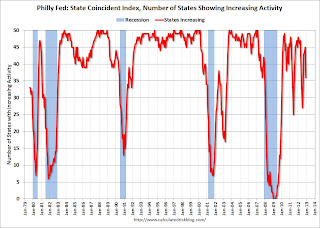by Calculated Risk on 1/22/2013 04:15:00 PM
Tuesday, January 22, 2013
Philly Fed: State Coincident Indexes increased in 36 States in December
From the Philly Fed:
The Federal Reserve Bank of Philadelphia has released the coincident indexes for the 50 states for December 2012. In the past month, the indexes increased in 32 states, decreased in 10, and remained stable in eight for a one-month diffusion index of 44. Over the past three months, the indexes increased in 41 states, decreased in seven, and remained stable in two (New Mexico and Wisconsin) for a three-month diffusion index of 68. For comparison purposes, the Philadelphia Fed has also developed a similar coincident index for the entire United States. The Philadelphia Fed’s U.S. index rose 0.2 percent in December and 0.6 percent over the past three months.Note: These are coincident indexes constructed from state employment data. From the Philly Fed:
The coincident indexes combine four state-level indicators to summarize current economic conditions in a single statistic. The four state-level variables in each coincident index are nonfarm payroll employment, average hours worked in manufacturing, the unemployment rate, and wage and salary disbursements deflated by the consumer price index (U.S. city average). The trend for each state’s index is set to the trend of its gross domestic product (GDP), so long-term growth in the state’s index matches long-term growth in its GDP.
 Click on graph for larger image.
Click on graph for larger image.This is a graph is of the number of states with one month increasing activity according to the Philly Fed. This graph includes states with minor increases (the Philly Fed lists as unchanged).
In December, 36 states had increasing activity, down from 45 in November(including minor increases). This measure has been and up down over the last few years since the recovery has been sluggish.
 Here is a map of the three month change in the Philly Fed state coincident indicators. This map was all red during the worst of the recession.
Here is a map of the three month change in the Philly Fed state coincident indicators. This map was all red during the worst of the recession. The map was all green early in 2012, than started to turn red, and is mostly green again.


